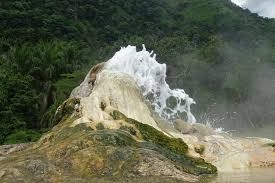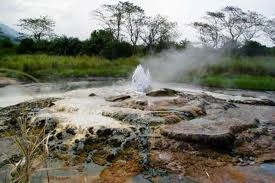Discovering Uganda’s Hot Springs.
The pearl of Africa is blessed with lots of hot springs that not only offer a blend of scenic beauty and therapeutic benefits but also allow visitors to experience unique cultural practices and recreational activities. Plan your visit to embrace the therapeutic magic and scenic beauty of Uganda’s geothermal gems
Formation of Hot Springs.
Hot springs are formed due to the geothermal activity that took place underneath the earth’s crust, after which created springs that bubble to the surface of the earth in the form of magma.
In Uganda, these springs are a legacy of the East African Rift System, which shapes much of the region’s geology.
Examples of hot springs in Uganda.
Sempaya Hot Springs.
These are located at Semuliki National Park in Bundibugyo District, and they are known for their dramatic boiling pools.
Sempaya hot springs are of high cultural significance to the Bamaga community.
Here visitors are involved in egg boiling in the hot waters as a demonstration of the extreme heat.
Kibiro Hot Springs.
These springs in Hoima district are part of the historic Kibiro salt gardens near Lake Albert.
Locals extract salt in a traditional process by adding a cultural element to the natural attraction.
Rwagimba Hot Springs.
These springs, which are surrounded by lush surroundings and are renowned for their scenic splendor, are situated in the Albertine Rift Valley in the Bunyangabu area.
Amuru Hot Springs.
These are lesser known and are in northern Uganda but of very high cultural significance. These springs offer serene experiences for visitors seeking quieter retreats.
Activities to Do at Uganda’s Hot Springs.
Therapeutic Soaking.
Many visitors are drawn to the hot springs for their rumored healing properties. The mineral-rich waters were heated naturally by geothermal energy.
Soaking in these warm waters provides a sense of relaxation and rejuvenation, making it a popular activity at springs like Rwagimba and Amuru.
Egg-Boiling Experience
The egg boiling activity is a unique and entertaining feature, especially done at the Sempaya Hot Springs in Semuliki National Park.
Visitors are invited to drop eggs or vegetables into the boiling pools where temperatures can reach over 100°C, and within minutes they’re cooked to perfection.
It’s a fun, family-friendly activity and a fascinating way to witness the intense geothermal energy.
Cultural and Historical Exploration
Many hot springs are steeped in local legends and traditions. Engaging with the surrounding communities provides an opportunity to learn about these cultural narratives.
Visitors can observe or participate in this traditional process, which has been passed down through generations.
This cultural immersion adds a deeper dimension to your visit, thus connecting you to Uganda’s rich heritage.
Nature Walks and Scenic Exploration
The hot springs are often surrounded by stunning natural landscapes, which are perfect for hiking or leisurely nature walks.
Visitors encounter lush vegetation teeming with wildlife such as monkeys, birds, and many more to enhance the experience by providing insights of the local flora and fauna.
Wildlife and bird watching.
Sempaya Hot Springs that are found in the heart of Semuliki National Park are home to over 400 bird species, including the rare shoebill and the forest hornbill.
You may also spot forest elephants, bush babies, and primates like red-tailed monkeys during your visit.
Camping and Picnicking.
Hot springs like Rwagimba and Amuru are ideal for picnics or camping.
These activities allow visitors to extend their stay and enjoy the serenity of the surrounding environment under starry African skies.
Photography.
The stunning views of the hot springs offer incredible scenic opportunities for photographers.
From the bubbling pools of Sempaya to the serene landscapes at Rwagimba, photographers will find plenty of captivating scenes to capture.
Early morning light or the golden hour in the evening provides the best conditions for breathtaking shots.
Community-Based Tourism.
Participating in community tours is a rewarding way to enrich your visit.
Many communities near hot springs, such as those around Kibiro, offer guided experiences that include storytelling, local cuisine sampling, and crafts.
Educational Tours.
Visitors interested in geology and natural sciences and guided tours, these geothermal sites provide insights into the science behind hot springs and the East African Rift Valley’s role in shaping Uganda’s geography.
These tours are particularly engaging for students and eco-tourism enthusiasts.
When to Visit
The dry seasons of December to February and June to August are ideal for better accessibility and favorable hiking conditions.




